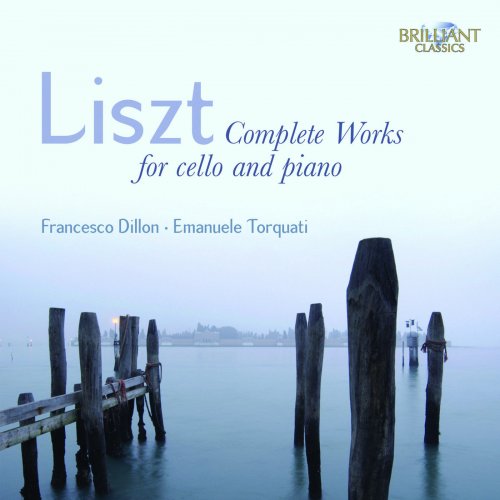
Francesco Dillon, Emanuele Torquati - Liszt: Complete Works for Cello and Piano (2011)
BAND/ARTIST: Francesco Dillon, Emanuele Torquati
- Title: Liszt: Complete Works for Cello and Piano
- Year Of Release: 2011
- Label: Brilliant Classics
- Genre: Classical
- Quality: FLAC (tracks)
- Total Time: 56:27
- Total Size: 214 Mb
- WebSite: Album Preview
Tracklist:
1. Première Elégie, S. 130 04:46
2. Zweite Elégie, S. 131 (1877) 04:28
3. Romance oubliée, S. 132 03:57
4. La lugubre Gondola, S. 134 08:10
5. Die Zelle in Nonnenwerth, S. 382 06:08
6. Pensées poétiques/Consolations pour Piano, S. 172: No. 1 in C Major - No. 4 in D-Flat Major 04:16
7. Pensées poétiques/Consolations pour Piano, S. 172: No. 2 in A Major 02:35
8. Pensées poétiques/Consolations pour Piano, S. 172: No. 3 in E Major 04:15
9. Pensées poétiques/Consolations pour Piano, S. 172: No. 5 in G Major 02:36
10. Pensées poétiques/Consolations pour Piano, S. 172: No. 6 in C Major 03:03
11. Angelus! (Prière aux anges gardiens), S. 163: 3ème Année, Italie 08:01
12. Liebestraum No. 3 in G Major, S. 541 04:12
Performers:
Francesco Dillon (cello)
Emanuele Torquati (piano)
1. Première Elégie, S. 130 04:46
2. Zweite Elégie, S. 131 (1877) 04:28
3. Romance oubliée, S. 132 03:57
4. La lugubre Gondola, S. 134 08:10
5. Die Zelle in Nonnenwerth, S. 382 06:08
6. Pensées poétiques/Consolations pour Piano, S. 172: No. 1 in C Major - No. 4 in D-Flat Major 04:16
7. Pensées poétiques/Consolations pour Piano, S. 172: No. 2 in A Major 02:35
8. Pensées poétiques/Consolations pour Piano, S. 172: No. 3 in E Major 04:15
9. Pensées poétiques/Consolations pour Piano, S. 172: No. 5 in G Major 02:36
10. Pensées poétiques/Consolations pour Piano, S. 172: No. 6 in C Major 03:03
11. Angelus! (Prière aux anges gardiens), S. 163: 3ème Année, Italie 08:01
12. Liebestraum No. 3 in G Major, S. 541 04:12
Performers:
Francesco Dillon (cello)
Emanuele Torquati (piano)
Many of Liszt’s works were transcribed for other instruments; both by the composer himself and other musicians. These hauntingly beautiful pieces for cello and piano were originally written for piano solo or the voice. They are from the final period of his life and are the product of his old age and his quest for spirituality. Far from the virtuoso brilliance of his earlier works, their intense and romantic melodies express melancholy and desolation, the sparse textures and harmonic instability daringly looking forward to the twentieth century.
The rich and warm expressive qualities of the cello undoubtedly make these pieces even more effective. The most significant work in this collection is La lugubre gondola, a compelling piece written after Liszt had a premonition of Wagner’s death. It was inspired by the Venetian gondola funeral processions he observed during a visit to the city to see Wagner. The music conveys the stillness of a Venetian lagoon, the unsettling harmonies also evoking the underlying darkness and despair. Another work with a very personal connection is the nostalgic Die Zelle in Nonnenwerth, a transcription of one of his songs. Nonnenwerth was an island in the Rhine where Liszt spent time with Marie d’Agoult and their children, and his fondness for the work resulted in many different versions for solo piano, voice and piano duet as well as this version for cello and piano. There are also transcriptions for cello and piano by other musicians of some of his most popular piano works, including the six Consolations, Angelus!
From the third volume of Années de Pelèrinages and the Liebestraum No.3. The performers of this moving collection of works are the Italian cellist Francesco Dillon and the pianist Emanuele Torquati. Francesco Dillon performs as a soloist and with chamber groups all over the world and has made several recordings of unusual cello repertoire, including an album of Schumann rarities for Brilliant Classics.
The rich and warm expressive qualities of the cello undoubtedly make these pieces even more effective. The most significant work in this collection is La lugubre gondola, a compelling piece written after Liszt had a premonition of Wagner’s death. It was inspired by the Venetian gondola funeral processions he observed during a visit to the city to see Wagner. The music conveys the stillness of a Venetian lagoon, the unsettling harmonies also evoking the underlying darkness and despair. Another work with a very personal connection is the nostalgic Die Zelle in Nonnenwerth, a transcription of one of his songs. Nonnenwerth was an island in the Rhine where Liszt spent time with Marie d’Agoult and their children, and his fondness for the work resulted in many different versions for solo piano, voice and piano duet as well as this version for cello and piano. There are also transcriptions for cello and piano by other musicians of some of his most popular piano works, including the six Consolations, Angelus!
From the third volume of Années de Pelèrinages and the Liebestraum No.3. The performers of this moving collection of works are the Italian cellist Francesco Dillon and the pianist Emanuele Torquati. Francesco Dillon performs as a soloist and with chamber groups all over the world and has made several recordings of unusual cello repertoire, including an album of Schumann rarities for Brilliant Classics.
DOWNLOAD FROM ISRA.CLOUD
Francesco Dillon, Emanuele Torquati - Liszt Complete Works for Cello and Piano.rar - 214.9 MB
Francesco Dillon, Emanuele Torquati - Liszt Complete Works for Cello and Piano.rar - 214.9 MB
As a ISRA.CLOUD's PREMIUM member you will have the following benefits:
- Unlimited high speed downloads
- Download directly without waiting time
- Unlimited parallel downloads
- Support for download accelerators
- No advertising
- Resume broken downloads


